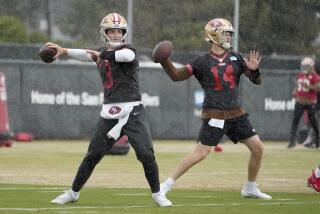49ers of the ‘90s Are Found Lacking
- Share via
The San Francisco 49ers aren’t what they used to be. They aren’t even close.
Though still effective at quarterback with Steve Young, they are a team with a fading defense--one that has just about disappeared.
In particular, the 49ers have lost their pass rush. After giving up on three exceptional defensive linemen in two years--Charles Haley, Pierce Holt and Tim Harris, who are now succeeding elsewhere--they seldom bother even a slow-footed quarterback these days.
What it means is clear enough: When the 49ers, after a bye week, play at Dallas today, they will discover that Cowboy quarterback Troy Aikman is perfectly placed for a big day. Nothing but a powerful rush disrupts Aikman, who can invariably find a receiver if he isn’t pushed.
And the San Francisco push is much weaker than it was even last January, when the Cowboys stopped the 49ers short of the Super Bowl.
*
Bench gone: The primary personnel difference between the 49ers under Bill Walsh in the 1980s and under George Seifert in the 1990s is that they no longer lead the NFL in bench strength.
During the 1980s, Walsh, when Seifert was his defensive coordinator, thought defense first. He brought in two responsible defensive players for almost every position, and at some positions he had three. Thus the 49ers under Walsh were the first to alternate defensive linemen throughout NFL games, keeping fresh pass rushers on the field.
Seifert no longer has that kind of talent. And so when injuries mount--as they did this fall, eliminating four defensive starters for a while--the 49ers are hard-pressed to compete.
Most recently, an opponent with an over-the-hill quarterback, Jim McMahon, played the 49ers close by attacking their pass defense brazenly. Of the Minnesota Vikings’ first 30 plays at Candlestick Park, 26 were passes.
With an Aikman in their lineup, the Vikings would have broken the game open.
*
Tough quarterback: Seifert, as the successor to a legend, is still coaching productively. Of his first 76 NFL games in four-plus years, he has won 60. That’s a winning percentage of .790, one of the highest in league history.
What’s more, as a decision-maker, Seifert is still guessing right most of the time. One option he had this year was to trade Young for a barrel of draft choices--several of them firsts--and play the season with Joe Montana and Steve Bono at quarterback.
That would have been popular in San Francisco.
Seifert reasoned, however, that Young at 31 is much more durable than Montana at 37. And that is proving to be so.
Montana has gone down and out of two games. By contrast, Young, so far, has survived extraordinary defensive assaults. In his last two games, Young has been sacked 10 times and punished repeatedly, going off once in the Minnesota game with a concussion.
He came back for the next play.
Possibly the toughest quarterback in the league, Young has one other unusual virtue. He plays at least as well in clutch moments as he does in any first quarter.
*
Unwise drafts: The 49ers have found a spot for a recent first-round draft choice, halfback Dexter Carter. He has become their punt returner and has a 15-yard average in a specialty in which a 10-yard average is commendable.
But good teams don’t waste first choices on punt returners.
Nor do they waste first choices on fat, unproductive nose tackles--a description that 49er fans reserve for theirs, Ted Washington.
One San Francisco first choice this year, starting linebacker Todd Kelly, has an unusual statistical record for the last three games: no tackles, no sacks, no assists, no interceptions, no nothing.
In the post-Walsh era, the 49ers aren’t drafting or trading well enough to remain competitive indefinitely, although with Young at quarterback, and with four other offensive aces--Jerry Rice, John Taylor, Ricky Watters and tight end Brent Jones--they are still one of the NFL’s major offensive threats.
*
Cowboys ignored: One of the oldest truisms in football is that losers copy winners. The strategists who, for instance, first proved the validity of the four-man secondary--replacing a unit with three defensive backs--have had many imitators.
NFL coaches are, in fact, influenced almost every season by whatever seems to be helping the current Super Bowl champion.
And that’s what makes 1993 different. No opponent has yet tried to emulate the Dallas Cowboys, who, in the most recent Super Bowl game, threw a record four first-down touchdown passes in routing the Buffalo Bills.
There are two successful short-pass offenses in the league today--Dallas’ and San Francisco’s--and everybody who is copying anybody is copying the 49ers. Or trying to.
And that’s strange, for, of the two, Dallas Coach Jimmy Johnson’s offense is much simpler to operate.
The heart of Johnson’s system is the way Aikman and running back Emmitt Smith are integrated.
Against Indianapolis last week, the Cowboys won with their familiar uncomplicated formula:
--They ran repeatedly on passing downs, when they handed the ball to Smith.
--They threw the ball repeatedly on running downs, when they called on Aikman for short passes.
As their peers say, Aikman and Smith have a load of talent, but the simple things they do aren’t beyond the capacity of many other pros.
The real problem elsewhere is that most coaches prefer to throw long on third down, blaming their quarterback for any interceptions, after trying to establish the run on first down, blaming their blockers for any imperfections.
More to Read
Go beyond the scoreboard
Get the latest on L.A.'s teams in the daily Sports Report newsletter.
You may occasionally receive promotional content from the Los Angeles Times.










